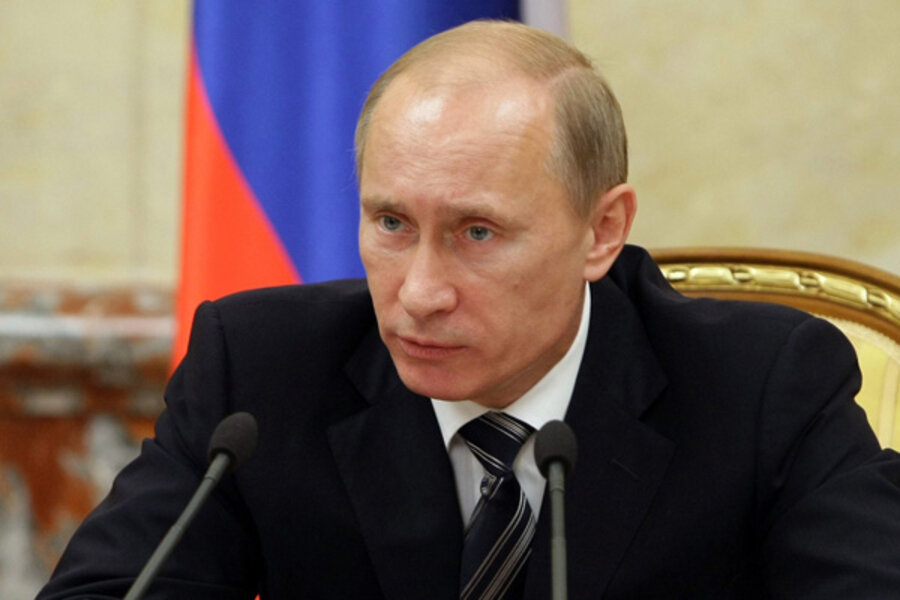Putin on the prowl to save world's endangered tigers
Loading...
| New Delhi
For centuries, villagers living in Asia’s forests, mountains and icy tundra have learned to fear and respect the mighty tiger. But rapid economic growth and modernization has turned the tables on the tiger, of which as few as 3,200 remain in the wild, mostly in India, Russia, and Indonesia.
This weekend, representatives of 13 countries will gather in St. Petersburg, Russia, to pledge support for the tiger, a rare example of a summit on behalf of a single species. The meeting will be hosted by Russian Prime Minister Vladimir Putin and has been in the works for two years.
Countries will outline plans to double the wild tiger population by 2022, the year of the tiger in China, which is also the largest market for tiger skins and body parts, according to researchers. Tigers once roamed much of Asia, but are virtually extinct in some countries due to poaching and forest clearance.
But, as with Afghanistan, the tiger summit is fraught with deep divisions over how to turn around an increasingly dire situation. Some conservationists are skeptical that the meeting will yield much. Others argue that it will attract political support to a broad-based conservation effort that requires a sustained focus to succeed.
A separate debate among conservationists is whether the current patchwork of tiger reserves is sufficient to stop the decline and if it should be replaced by a smaller number of "source sites" where female breeding tigers are found, effectively giving up on marginal populations.
There is also controversy over a Chinese proposal to allow a trade in farmed tiger parts, though this has been left off the summit agenda. Critics say that breeding captive tigers for slaughter wouldn’t quell the demand for wild tigers, which are used in traditional Chinese medicine for various ailments. Proponents say farmed tigers would relieve the pressure on wild populations.
India's economic boom eating into tiger conservation zones
The debate over how to save the tiger has resonance in India, home to over 1,400 wild tigers. Its delegation to St. Petersburg will be led by the head of the National Tiger Conservation Authority, an agency created in 1973 in response to a drastic fall in tiger numbers. India has 39 reserves and six conservation zones for tigers, though some have been depleted by poaching.
This commitment predates India’s recent rapid economic takeoff. “We’ve been spending money on tigers, even when the chips were down,” says Ravi Singh, secretary general of WWF in India.
But India’s economic boom isn’t necessarily a plus for its rich wildlife. A rush to develop rural areas, dig mines, and build road has eaten away at forest reserves where tigers roam, often over hundreds of miles in search of prey. Corruption and low morale is blamed for the failure of forest rangers to protect wildlife.
What galls some critics of the tiger summit is that its main backer, the World Bank, has a checkered record in India. While its president, Robert Zoellick, helped launch the two-year Global Tiger Initiative, the bank continues to fund coal-fired power stations and other development projects in India with major environmental impacts, including on forests.
“There’s a fatal flaw in the whole thing and that’s the World Bank. That’s where the problem is,” says Bittu Sahgal, editor of Conservation Asia, a magazine published in Mumbai. He claimed the bank was trying to green-wash its image. Bank officials have argued that coal is an unavoidable part of the energy mix in countries like India and China.
An estimated 104 tigers killed per year
Even the idea of a summit to save a single species may raise eyebrows. But conservationists say that focusing on a large, iconic predator like the tiger makes sense, as safeguarding its habitat also protects other species living there. The tiger initiative also aims to promote poverty reduction in catchment areas and carbon emission allowances for countries that set aside wildlife-rich forests.
Some critics say this extra baggage obstructs the pressing need to protect vulnerable wild tigers in countries like Russia and Indonesia, and to stop the illegal trade in tiger parts that is fed by Chinese demand. TRAFFIC, a wildlife monitoring agency, recently calculated that seizures of tiger parts and skins since 2000 suggested that at least 104 tigers were slain annually, a figure that omits those tiger products that evaded capture as well as natural mortality.
Samir Sinha, the head of TRAFFIC in India, argues that the summit’s holistic approach to tiger conservation is valid. “It’s basically ticking the boxes you like. But it filters into saving the species,” he says.
National reserves, or natural corridors?
Experts differ on how this might be done. A group of academics recently proposed the “6 percent” strategy, which would protect only national reserves with viable numbers of breeding tigers. Other reserves would be abandoned. The idea would be to revive the wild population by concentrating resources on 6 percent of the historic range of tigers in Asia.
This approach contrasts with the "landscape" strategy of WWF and other conservation groups, which aim to preserve natural corridors outside protected areas so that tigers can roam more widely. Mr. Singh points out that breeding tigers on core sites would eventually create a dilemma of what to do when the population is too large for its habitat. It would also be hard to take back land that had been given up for development, which is likely to accelerate if India continues its economic boom.
“If we only look at the conservation sites and give up the rest it will be lost forever,” he says.





